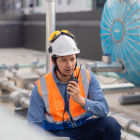All properties in the UK and most around the developed world will have some degree of heating and cooling system in place. This can range from quite basic systems to more sophisticated and more effective systems. There are however, a number of typically utilised heating and air conditioning systems in the UK which are used to regulate and maintain temperatures inside properties.
It is often useful to be aware of the main types of heating and air conditioning systems that are available, to provide some clarity on what is available to you in your property, circumstances and budgetary constraints, so you are able to make an informed decision as to which will be the best option for you. It is also important to make sure your property receives the most energy efficient system possible, making for a more efficient property helping to ensure compliance with BREEAM ratings.
Also, for new properties, heating, ventilation and air conditioning systems are likely to require ventilation testing and commissioning as part of UK Building Regulations.
Central Heating Systems
There are a few different categories of central heating systems that are available in the UK; all of which are designed to provide and distribute warmth to your home. Alongside proper property insulation, having effective heating systems in place, can ensure properties are ventilated and heated properly.
Central heating systems typically fall into one of the following categories:
Storage Heaters – Storage heaters are typically heated overnight using Economy 7 (off-peak electricity) as well as on Economy 10 tariffs for a shorter period of time during the day. The heat that has been stored is then released gradually over the course of the following day.
A storage heater will usually have two controls, one is used to control the amount of electricity that is used, and another that it used to control the amount of heat that is released. This gives you the ability to control and delay the release of heat if you wish to (for example, because you are out during the day.)
Warm Air Systems – Warm air systems were more commonly utilised in the UK during the sixties and seventies. This type of heating system works by heating the air through a boiler (usually fuelled with natural gas, and is then fed to rooms around the property through ducts.) The air then enters the room, typically through a wall vent or through the floor. Maintaining your boiler is also key.
Whilst less common in residential buildings in the UK these days, having been mostly replaced with the use of ‘wet’ systems, they are still quite common in commercial buildings, where they may also be used as a cooling system.
Wet Systems – This kind of heating system heats a property via hot water that circulates through the property via a system of pipes connected to radiators around the property. A boiler burns the fuel (occasionally this may be a heat exchanger) and this helps to heat water that goes into the pipes. This type of heating is by far the most popular kind the UK, often referred to as ‘central heating.’
Radiators help deliver most of the heat provided through air that is warmed in the radiator through the process of convection, helping to warm rooms, which have radiators. With these systems, you should ensure you get your boiler checked by an accredited engineer to ensure you avoid the dangers of Carbon monoxide poisoning and maintain an efficient system and overall energy efficiency for the property in question, which should be reflected in a Standard Assessment Procedure (also known as SAP calculation).
Types of Air Conditioning Systems
Whilst not as widespread in the UK as it is in many other countries, air conditioning can often fulfil the role of heating and cooling or ‘conditioning.’ There are, as with heating systems, a number of different types of air conditioning systems. Important to note is that air conditioning may use a great deal more energy than traditional heating systems, so considering a smart meter alongside air conditioning may be an option to help manage energy usage.
Generally speaking, air conditioners will fall into one of the following categories: Monoblock, split-system or multi-split.
Monoblock Air Conditioners – This refers to where the air conditioning unit consists of just one block, and is specifically designed to be placed inside the building, but they still have an air pipe that is connected to the outside in order that the heated air can be transferred to outside of the property.
These can come in the form of floor or wall mounted and may be a good air conditioning option if there are planning restrictions that make it difficult to place an external condenser either on or near the building in question. They may have better functionality, and are often quieter than other air conditioning systems.
Split Air Conditioning – ‘Split’ air conditioning can refer to a number of different air conditioning systems. These comprise of conditioners that have both outer and inner components, both of which are connected by an electric cable and two copper pipes. Modern split air conditioning systems often come with a remote control, as well as a heat pump facility that can be used during the winter months.
This provides the opportunity to effectively control the temperature of the room, helping to keep it within 1-2 degrees of the temperature setting and many can be pre-programmed or come with various control modes and timers. These can be floor mounted or wall mounted, depending upon personal preferences.
If you rent a property, it may be worth choosing easy fit split air conditioners as opposed to alternative, more permanent options.
Multi Split Air Conditioning – These work similarly to split air conditioning systems, except for the fact there are a number of different indoor units that are all linked to the same unit externally. This type of air conditioning also requires considerably more powerful condenser units.
How to Choose an Air Conditioning System
When deciding which best air conditioning system is best for you, it is wise to take into consideration the following:
- What type of unit will you require
- Consider other factors that will be important to such as noise, cost, aesthetics as well as its physical size and function
- Carefully consider the cooling capacity of the unit that require
The post Heating and Air Conditioning Systems appeared first on RJ Acoustics.



